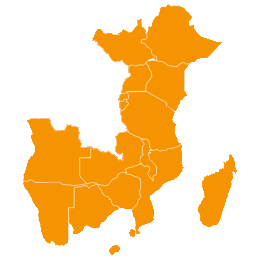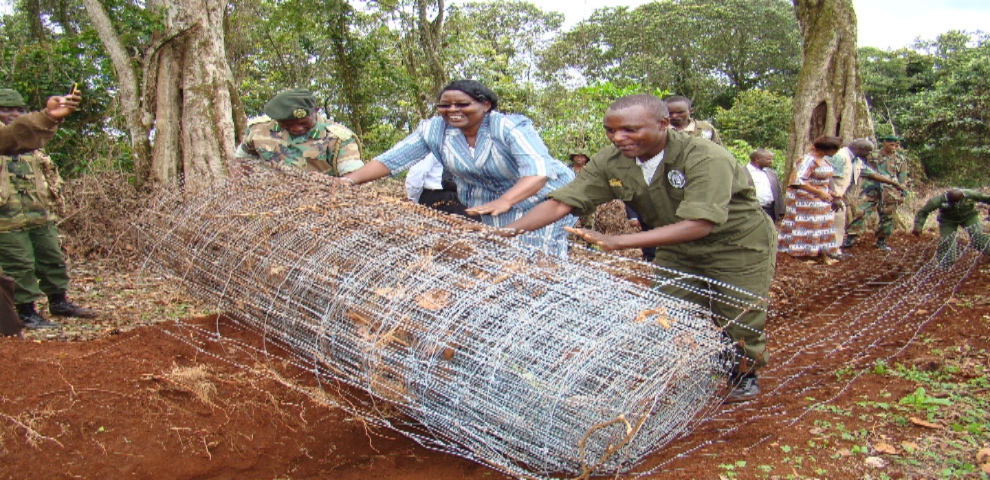Human-wildlife conflict management
“Carrots, cabbages and Irish potatoes are elephant delicacies that could not be grown before the fence was constructed. I am now at liberty to plant crops at any time of the year, which allows me to fetch the best prices in the market. I’m also able to enjoy my sleep without interruptions from invading elephants.”
Mr. Mbaya, horticultural farmer in Meru CountyBACKGROUND
For the farming community living near the Mt. Kenya forest, human-wildlife conflicts (particularly caused by elephants) have been a regular occurrence for as far back as anyone can remember. Elephant attacks can damage property, ruin entire crop fields and livelihoods and cause injury and death. The UTaNRMP project constructed a 60-kilometre solar-powered human-wildlife control fence that separates the forest from farmlands
WHAT’S INVOLVED
A wildlife control barrier: A solar-powered electric fence with eight strands of wire and a one-meter mesh section at the bottom that prevents burrowing animals from crossing over into farmlands.
Public-private producer partnership: A collaboration among the government, private companies and local communities that reduced expected fence construction time from six years to two years.
EXPLORE THIS SOLUTION
Partnerships in fencing for human-wildlife conflict can offer:
- An innovation to mitigate human-wildlife conflict
- A strategy for efficiently implementing a local project

Countries involved
Kenya
Project partners
Kenya Forest Service, Kenya Wildlife Service, Mt. Kenya Trust, Rhino Ark, Local Communities, Community Forest Associations and County Governments of Meru, Tharaka Nithi, Kirinyaga, Embu and Nyeri
Project dates
2012 – Present
Share this solution
Bookmark this solution
BookmarkShow Full Solution
Summary
The Upper Tana Natural Resources Management Project (UTaNRMP) aims to increase sustainable food production and improve sustainable management of natural resources in Kenya. To limit conflict arising from the proximity of human settlements to wildlife habitats, a solar-powered wildlife control barrier was constructed in the forest near Mt. Kenya in collaboration with local communities, public actors and private organizations.
Challenge/Problem
Rural development in Kenya is constrained by the proximity of human settlements and farmlands to the periphery of Mt. Kenya Forest. This proximity can harm human livelihoods, ecosystems and wildlife and forest reserves. Wildlife control fences along sections of Mt. Kenya have been used to reduce these problems. The fences were previously installed independently, either by government agencies or the private sector. The end result has been slow implementation and delays in providing benefits to the target population. Therefore, innovation was needed in the approach to fencing and fencing materials.
Solution
The primary innovation has been the use of the public-private-producer partnership (4Ps) approach, which brought together key players in the private and public sectors to control wildlife using a solar-powered fence. The short period of time it took to complete the project attests to the effectiveness of the 4Ps approach.
The 4Ps agreement involved the UTaNRMP project, government agencies (Kenya Wildlife Service and Kenya Forest Service) and the private sector (Rhino Ark and Mount Kenya Trust). To formalize the partnership, a management agreement was developed, stipulating the specific roles and responsibilities of the partners. Under the management agreement, UTaNRMP procured fencing materials while the Kenya Wildlife Service provided technical backstopping, supervised security and built and maintained energy storage houses. Rhino Ark and Mount Kenya Trust were assigned the role of constructing the fencing and overseeing other day-to-day operations, and the Kenya Forest Service aligned the fences and built community gates. The community forest associations provided labour and participated in the fence construction committees.
The construction of a solar-powered fence resulted in fuel cost savings and subsequently reduced greenhouse gas emissions. The use of recycled plastics as poles is also innovative because it contributes to the reduction of plastics in the environment and the felling of trees for fencing material.
The partnership effectively delivered 60 kilometres of eight-strand comprehensive fencing in two years instead of the planned six years, thereby allowing the target community to benefit from the fence earlier than scheduled.
Results
The innovation has resulted in socio-economic benefits to the communities living near the fenced areas. Benefits to the ecosystem and the government include:
- Changes in land cover: the natural forest cover has increased due to regeneration and enrichment planting, whereas grassland has declined by 62 per cent. There is clear physical evidence of regeneration of flora and fauna. The number of elephants and antelopes, which are no longer being poached, has risen.
- Crop diversification: 91.4 per cent of farmers in the vicinity of the fenced area now engage in cropping, a 75.9 per cent increase. Farmers have also introduced new crops, such as bananas, and adopted new technologies, especially for irrigation.
- Reduced management costs: the cost of responding to human-wildlife incidences was reduced by 94 per cent for government agencies.
- Better health: fewer wildlife attacks, reduced exposure to unfavourable weather conditions when guarding against wild animals and improved nutrition stemming from the availability of varied food crops all contributed to increases in health.
- More tourism: the fenced section of Mt. Kenya Forest has one national forest reserve gate (Chogoria), which leads to a national park gate. The gate has reported a 47 per cent improvement in tourism revenue.
Lessons Learned/Potential for replication
The key lesson learned is that the collaborative nature of a strategic partnership based on a defined set of partnership skills and resources can achieve more effective and efficient outcomes. Because of the consultations and negotiations involved, initial costs might appear time-consuming and high, but in the long term, the investments in terms of both time and money are worthwhile.
Next Steps
The scaling up and sustainability of fencing projects require community ownership from the planning, implementation and operation stages; clear overall ownership and responsibility for technical backup to ensure fencing provides the required services efficiently; quality designs and specifications for materials to ensure longevity and effectiveness; and maintenance schedules and security staff arrangements for the fence equipment.
Solution Additional Resources
Upper Tana Natural Resources Management ProjectLast update: 22/07/2021


